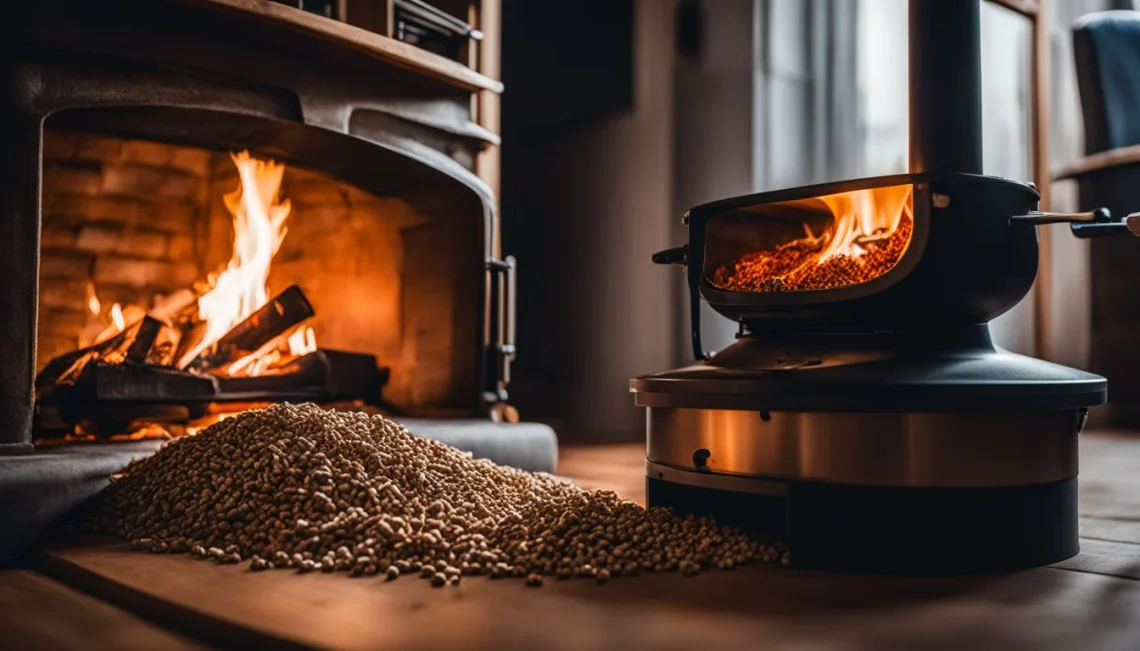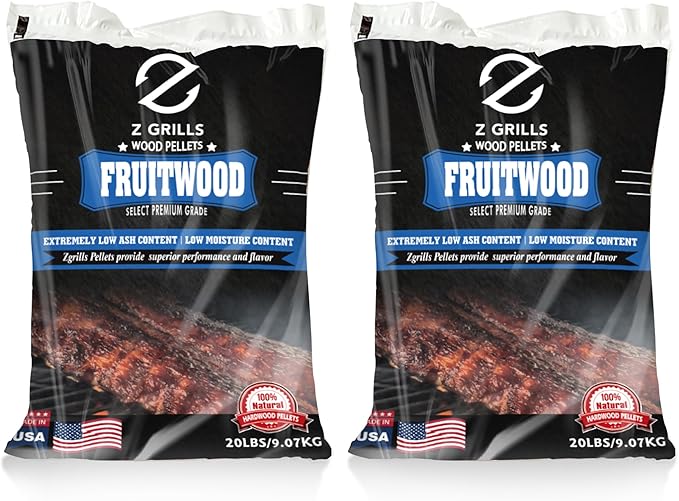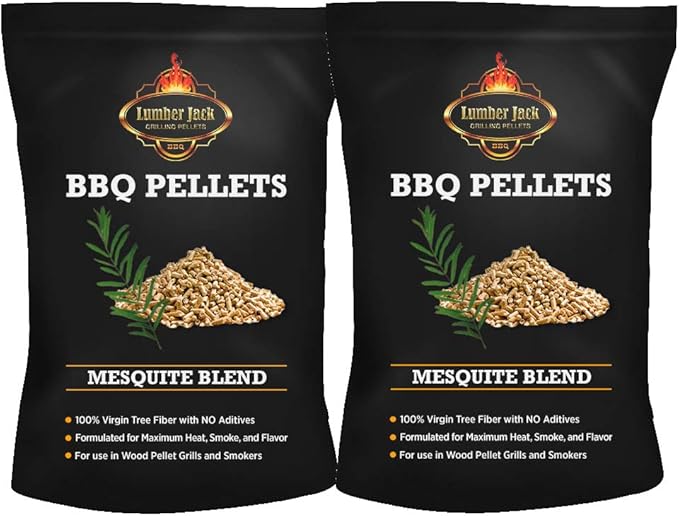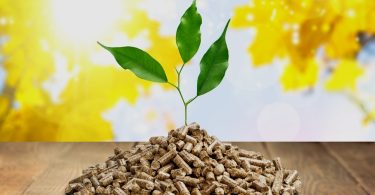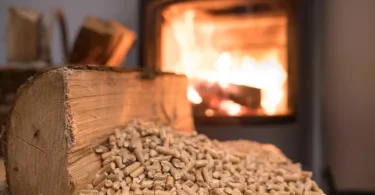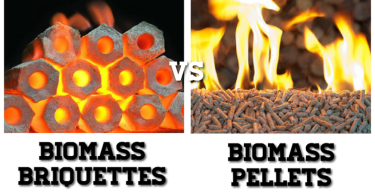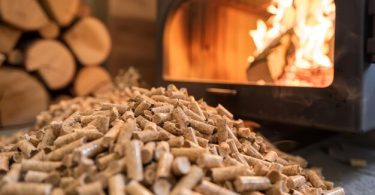Fuel pellets, or wood pellets as they are otherwise called, are essentially biofuels. As the name indicates, they are produced from compressed wood fiber and feature biomass materials. These materials include bark sawdust, wood chips, and related byproducts. Biomass fuel pellets are undoubtedly the best choice because of their high heat value and purity. They also enhance the life of pellet stoves because they do not contain phosphorus or sulphur.
Some fuel pellets contain industrial waste from manufacturing furniture and wood products or lumber milling. Industrial waste sources like coconut and palm kernel shells, empty fruit bunches, and branches and tops of trees that are discarded during logging are also used.
Wood pellets are generally cylindrical with a diameter of 1 cm or less and are polycrystalline in nature. In an optimized environment, they generate very little ash when burnt at extremely high temperatures. The actual burn temperature times depend on parameters such as pellet type and wood diameter.
Ideally, fuel pellets have very little moisture content and an extremely dense texture. These properties along with their small and uniform size help the pellets to portray high combustion efficiency when they are burnt. Moreover, their high density allows the pellets to be stored and/or transported for a long time or over a long distance.
IN A HURRY ? Here’s The Top 3 Wood Pellets For Pellet Stoves In 2024
Grades of Wood Pellets
There are primarily two grades of wood pellets that can be used in a pellet stove. Based on these grades, the pellets are classified as premium wood pellets and standard wood pellets.
- Premium Wood Pellets – These pellets are free of any kind of bark, additives, or glues. They are completely safe to use and mostly manufactured from maple wood or oak wood. The pellets feature a BTU range of 8000 to 8500 BTUs that help them to burn efficiently and hotter with minimum waste. On the flip side, they tend to be costlier than the standard pellets.
- Standard Wood Pellets – These pellets are produced from the factory industry waste that is left behind after manufacturing the premium pellets. They burn faster than the premium pellets and are more affordable. However, they feature an organic ash content rate of 1% to 3% resulting in more cleanup to be done after use when compared to the premium counterparts.
The type of fuel pellets used varies from country to country. For example, oak pellets are most often used in the United States. On the other hand, ash pellets are preferred in the United Kingdom.
Quality
The quality of wood pellets is largely determined by the region where the wood originated. For example, it is possible to procure the wood from the same trees grown in dry and wet areas. Needless to say, the fuel pellets made from wood procured in damp areas will have higher moisture content.
Advantages
Using fuel pellets has many advantages. They are cost-efficient and convenient to use. These pellets can usually be sourced easily and have several benefits. Apart from cooking, wood pellets are also a good choice for power generation and heating.
Wood pellets have several noteworthy advantages over fossil fuels that make them worth considering. Some key advantages of fuel or wood pellets are given below.
- Wood pellets are a low-cost and renewable fuel option. This is because wood is much cheaper than resources like electricity, oil, and gas. Additionally, these pellets can be procured from local sources.
- Fuel pellets have no bark and very little residue. As a result, they leave behind minimum ash when compared to regular firewood which produces more ash because of their bark content.
- Wood pellets have a compact or small size. This makes them easy to handle and transport from one place to another. They are usually available in various measures for users to pick up the quantity according to their needs.
- Fuel pellets are environment-friendly as they are made from wood processing byproducts.
- Wood pellets are compatible with a wide range of heating systems. Apart from pellet stoves, they can be used in furnaces and boilers as well.
Disadvantages
The main drawback of fuel pellets is noticed when they are used for heating purposes. While they can heat small spaces effectively, they may not deliver uniform warmth throughout a large area. Another flip side is that they tend to be affected by temperature and moisture changes. This is because of the wood shavings and compressed dust that are used to make them.
When these pellets become wet, they are often not capable of performing as effectively as when they are in the dry state. Fuel pellets are easily prone to get damaged if they are stored in a too cold or too hot place. Moreover, they can be used only in equipment that are specifically designed for these pellets.
Types of Wood Pellets
Wood pellets are broadly classified into hardwood pellets and softwood pellets according to the tree the wood for the pellets is sourced from. Both types can be mixed and used as long as the guidelines set by the manufacturer for optimum performance are followed. Read Full Post Here : Hardwood Vs Softwood Pellets
- Hardwood Fuel Pellets : In hardwood fuel pellets, the wood is sourced from deciduous trees or similar trees such as birch, maple, or oak. These pellets have high density and burn slower and for a long time because of their denser composition. They have a subdued and steady flame and offer a consistent and long-lasting heat output.
These pellets have low resin content and high mineral content resulting in more ash production and causing the appliance to need frequent cleaning. The ash produced is typically thrice as much as that of softwood pellets, resulting in more residue. Hardwood pellets tend to be a tad expensive and leave a fairly high carbon footprint because of their low energy density.
- Softwood Fuel Pellets: For softwood fuel pellets, the wood is obtained from coniferous trees or trees like fir, spruce, or pine. The pellets burn hotter than their hardwood counterparts owing to their higher energy output, which helps them to ignite quickly. The flame from these pellets is vibrant, lively, and intense resulting in quick heat production.
These pellets have high resin content and low mineral content resulting in less ash production and therefore reduce the frequency of cleaning the appliance. Softwood pellets are comparatively more affordable and more environment-friendly owing to their high energy density.
Hardwood fuel pellets and softwood fuel pellets go through the same manufacturing process. The burning process is not much dependent on the wood used to make the pellets. It is majorly influenced by the method used to manufacture them and the manufacturing quality.
There is also a third type that is referred to as blended pellets. These pellets are a combination of hardwood and softwood pellets.
Irrespective of the type of pellets, they must be stored in a well-ventilated and dry area where there is no possibility of moisture absorption. Moist pellets tend to lose their quality and the combustion efficiency of such pellets is also affected. The pellets must be handled properly during loading and transportation so that they do not get damaged.
Choosing the Right Fuel Pellets
Deciding whether you need hardwood or softwood fuel pellets is a matter of personal preference and based on need. Whichever type you opt for, there are some key factors to be kept in mind that can help you buy the right fuel pellets.
A careful study of the different values mentioned in the wood pellets packet can guide you in making an informed buying decision.
-
Pellet Diameter
Check the diameter of the pellets cited in the label on the packet of the fuel pellets. Ideally, the pellets should have a diameter ranging from 6 mm to 8 mm. Wood pellets of high quality are firm with an even size and solid consistency.
-
Humidity Percentage
Look out for the humidity percentage mentioned on the label. Ideally, this value should be as low as possible. This is because as the humidity of the pellets increases, their calorific power decreases. As a result, the dirt accumulation inside the combustion chamber tends to become high.
It is recommended that the humidity content of the pellets is not more than 8%. Wood pellets that have over 10% to 15% moisture content often do not burn uniformly.
-
Ash Residue
This is another important parameter that must be checked on the cover of the wood pellets. This will give you an idea of the dirt left behind inside your pellet stove after use. A low value for fixed residue percentage indicates that the pellets are of good quality. This is because the combustion is better when the fixed residue percentage is low.
-
BTUs
BTU stands for British Thermal Unit and is a measure of energy. Wood fuel pellets typically have a BTU varying between 8000 BTUs and 8900 BTUs per second on average. This value will be mentioned on the cover of the pellets.
The actual amount of BTUs needed for a pellet stove depends on multiple factors such as the space to be heated, the kind of insulation, and more. The lesser the area to be covered, the fewer BTUs you will need from your pellets.
-
Pellet Composition
Check what ingredients are used to make the pellets. Some wood pellets have additives included in their raw materials. These additives can hamper the pellet quality and in turn their performance.
-
Energy Density
Look out for the calorific value or energy density mentioned on the cover. Fuel pellets with high energy density burn for a longer time and also produce more heat.
-
Pellet Certification
Check the pellet sack for the quality certifications of the pellets. There are essentially four certifications that help to determine pellet quality standards. They are EN PLUS, ONORM, Din Plus, and Pellet Gold.
Wood pellets are divided into three categories based on the EN PLUS certification. The best or top-quality pellets that have an ash content of not more than 0.7% are given an A1 rating. Second-grade or medium-quality pellets featuring an ash content not higher than 1.2% have an A2 rating. Lastly, low-quality pellets with up to 2% ash content are assigned a B rating.
ONORM M175 and Din Plus are Austrian and German certification bodies that certify the quality of the fuel pellets. Pellet Gold, developed by AIEL, also helps to assess the quality of the pellets.
There are a couple of tests that can help to identify the quality of the fuel pellets if you want to do so with a sack that you have bought already.
The first test is a sawdust test. Examine the contents of the wood pellet sack carefully to check how much sawdust there is in it. A little sawdust is fine but if there is too much, the pellets are likely to start falling apart as a sign of low quality. The dust from these pellets can enter the components of the pellet stove and trigger a malfunctioning action.
If there is not much sawdust, a water test can be done next. Drop some wood pellets into a container of water and observe them. If they settle down at the bottom and the water remains clear, the pellets are of good quality.
It is recommended to use fuel pellets made of dried sawdust rather than using wood pellets with wet sawdust or wood pellets made from a mixture of dry and wet sawdust. Pellets that are manufactured from wet materials more often than not feature high ash content. Such pellets can pose a threat to the environment especially if they are put to use indoors.
Top 10 Fuel Pellets Worth a Buy
When you have decided on the type of wood pellets that you want to buy, you can always head to the nearest retailer or check out for a sack online. However, with the various brands available, picking the right fuel pellets can be overwhelming or a daunting task.
We have shortlisted 10 different best fuel pellet options for you and mentioned their highlights along with pros and cons. This list will make the buying process easier for you.
1- Z GRILLS Fruitwood Flavor Fuel Pellets
The Z GRILLS hardwood fuel pellets are completely natural and free of additives, fillers, and binders. The pellets provide an excellent wood-fired flavor to your vegetables, different types of meat, and even baked food to elevate the barbecue experience. The clean-burning action makes the surroundings less messy.
The pellets are kiln-dried and retain the optimum moisture content to ensure that you get the ideal flavor all the time along with the perfect burn-to-smoke ratio. They produce 8500 BTUs and burn clearly, thus making them safe for the air as well as the surrounding environment. These pellets can be used with almost all kinds of barbecues and smoker grills.
The smoke from the fire is high and also has a rich and pleasant smell when these hardwood pellets are used. The pellets help to maintain the grill temperatures. It is very easy to store and handle these pellets. Once they are added and the desired temperature is set, the Z GRILLs hardwood fuel pellets infuse the flavor into the food while also burning for a long time.
Pros
- Very little ash residue
- Eco-friendly fuel
- Ideal burn-to-smoke ratio
- Available in packs of 40 pounds and 20 pounds
Cons
- Holes on the sides of some 20-pound bags
- A bit pricey compared to some other brands
2- Solo Stove Less Ash Wood Pellets
The Solo Stove hardwood fuel pellets are made from renewable, recycled, and fully natural sawmill residue. This makes the pellets eco-friendly and safe to use. The biomass for the pellets is sourced locally. These pellets create a traditional wood-burning campfire experience. With absolutely no additives added, the roasted food is undoubtedly safe for consumption.
The pellets can be burnt in any kind of appliance. With the manufacturer’ Tower, they deliver 72000 BTUs while with Mesa, they render slightly more than 8000 BTUs. On an average, the BTU rate is 8,100 to 8,300 BTUs per pound. These pellets help to give the roasted food the perfect color and texture. The wood pellets burn evenly and efficiently owing to their special consistency and formulation.
The pellets have low moisture content and thereby produce minimum smoke resulting in very little ash getting generated. About a quarter cup of the pellets can be added every five to eight minutes after the original flame starts dropping so that their burn rate is close to one pound every hour. These Solo Stove hardwood fuel pellets must be stored in a sealed container or packing in a dry and cool place and away from moisture.
Pros
- Very fast starting of fire
- Good burn time
- Simple and easy to use
- Ideal for small pellet stoves
Cons
- Slightly expensive
- Short fire duration for some users
3- Lumber Jack Multiple Flavors Wood Pellets
The Lumber Jack hardwood pellets are free of any kind of artificial ingredients and also do not contain binders, sprays, or oils. The pellets are made from the cambium layer and bark of actual trees which makes them safe to use and helps to enhance the flavor of the food. They are made from 60% pure red oak wood trees and 40% Mesquite.
The grilling pellets are manufactured after the fiber is blended properly so that each pellet burns the same way with high consistency and quality while ensuring that the smoke is consistent throughout the use. Each pellet has a small diameter and ensures that the food flavor is not affected in any way. The pellets deliver a rich flavor without any bitterness.
The wood pellets are a good choice for your barbecue equipment. The pellets are best suggested for lamb, beef, pork, and poultry for that typical tangy barbecue taste. The Lumber Jack hardwood fuel pellets are available in 20 lbs. and 40 lbs. bags in pure and blended mixtures.
Pros
- Easy to carry around
- Available in over five distinct flavors
- Hotter burn over a large surface area
- Good pellet size
Cons
- Flimsy bag tending to tear easily
- Does not enhance the flavor of vegetarian dishes as much as meat
4- KonaGrill Type Wood Pellets
The Kona hardwood fuel pellets are especially suited for barbecues and are meant to be used with Ninja wood fire outdoor grills and wood fire ovens and smokers. The pellets are made from the wood of carefully selected trees to enhance their flavor. They are available in eight different flavors in a 1 lb pack allowing users to choose from versatile and diverse flavor profiles.
The pellets can also be used with almost all grill types. They can be kept over direct heat for a couple of hours of smoking time or on the side of the grill and lit with a pencil torch for five minutes and then blown out.
The wood pellets offer assurance of a great flavor. They are known for their high BTU and feature low moisture content. Their clean-burning action ensures that they leave very little ash behind. The Kona hardwood fuel pellets burn uniformly and better than many other pellets and produce a thin blue smoke that appeals to most barbecue and grill lovers.
Pros
- Wide range of flavor profiles
- Less quantity needed for each use
- Good value for money
- Good burn time
Cons
- Not suitable for cheese smoking
- Cannot be used with hopper-fed pellet grills
5- Kingsford Versatile Flavor Wood Pellets
The Kingsford hardwood fuel pellets are wood smoker pellets made of completely natural hickory hardwood sourced from North America without any fillers, binding agents, or artificial flavors. The pellets can be used in charcoal, gas, and pellet grills such as wood pellet smoker tubes and DIY smokers. They can be paired with various vegetables and meat options like turkey, lamb, pork, chicken, and beef.
The pellets render a savory and strong flavor that makes them the right choice to use when cooking beefy food like short ribs, prime rib roast, and ribeye without affecting the quality. They are not only great for grilling but also for roasting and baking. These wood pellets enhance the flavor of just about anything that is cooked using them.
The pellets also last a long time once they are burnt. Based on the outdoor conditions and grill used, a pound of these pellets lasts about half an hour at high heat and an hour at low heat. The Kingsford hardwood fuel pellets enhance the flavor when the grill is kept closed.
Pros
- Great smoky flavor
- Excellent taste and smell
- Works well with all kinds of meat cuts
- Compatible with all barbecue smokers and grills
Cons
- Occasionally takes a long time to burn
- Less smoke compared to some other brands
6- Fire & Flavor Aromatic Smoke Wood Pellets
The Fire & Flavor hardwood fuel pellets are dried and seasoned to render a versatile flavor and quality to the food. The pellets work well in both pellet grills and smokers. They are suitable for not only smoking alone but also baking and grilling at any temperature. They are easy to use and leave behind no excessive dust or ash after use.
The food-safe wood pellets produce an aromatic smoke that blends perfectly with seafood, pork, chicken, and vegetables with their distinct sweet and subtle flavor. These pellets burn nice and hot and retain the heat throughout the cooking process. They work well with coal in a charcoal grill. The raw materials for making the wood pellets are sourced locally.
The fuel pellets come in different variants like the manufacturer’s signature blend flavor and standard flavors like apple, mesquite, hickory, and cherry. The pellets are reasonably priced and perfectly sized. The Fire & Flavor hardwood fuel pellets work true to their name and add a natural flavor to the food irrespective of what kind of cooking they are used for.
Pros
- Suitable for both high and low temperatures
- Free of additives and chemicals
- Works well in outdoor ovens
- Provides ample heat
Cons
- Shorter than some other brands
- Less burn time
7- TIKI Smokeless Wood Pellets
The TIKI hardwood fuel pellets light up almost instantly with just one match and leave behind very little smoke. The pellets are manufactured using upcycled sawdust sourced locally. They work seamlessly with smokeless pits from any manufacturer. These pellets are not suitable for pellet burners, smokers, and grills. They are intended to be used only outdoors.
The wood pellets are safe to use because they have only natural ingredients. These pellets have a burn time of around half an hour. They must be kept out of reach of pets and children. The pellets are reasonably priced and worth the money you pay for them.
These pellets produce heat up to a radius of four feet and deliver a real wood fire experience. They are the right choice for those who want a no-mess solution and very little cleaning after use. The TIKI hardwood fuel pellets deliver a natural wood flavor and come as a set of four packs with each pack weighing 9 pounds.
Pros
- Ideal for people allergic to smoke
- Fast lighting action
- Easy to transport to any place
- Safe for the environment with eco-friendly packing
Cons
- Only one flavor available
- Additional wood needed to extend the fire time
8- Fire & Flavor Food-Safe Wood Pellets
The Fire & Flavor hardwood fuel pellets are manufactured using the right standards to go that extra mile and deliver a versatile flavor for just about any kind of cooking. The pellets work great at low temperatures for slow and low smoking. They are also ideal for grilling at high temperatures.
The wood pellets produce an aromatic smoke that delivers a subtle flavor that is just right for seafood, chicken, and vegetables. These pellets get started with doing their job as soon as heat is applied to them. They combine high quality with a premium flavor. The pellets have a reasonably large size that helps them to burn for a long time.
The fuel pellets render a sweet smoky touch to any food that is cooked with it. They work best with pellet smokers and grills. The apple-flavored pellets are sure to enhance the taste of chicken wings. The Fire & Flavor hardwood fuel pellets come in a 20 lbs. pack that ensures that there are enough pellets to go for cooking many times.
Pros
- Perfect smoked texture for any meal
- Good price for the quantity
- Can be used along with coals in a charcoal grill
- No clog formation
Cons
- Burns out faster
- Tendency of cover tearing soon
9- J.C’s Smoking Electric Smoker Wood Pellets
The J.C’s Smoking hardwood fuel pellets are manufactured using pure oak from virgin hardwood trees found in Missouri and Central Iowa. They are specifically intended to elevate the barbecuing experience.
The wood pellets have no binders or additives in them. They can be used by following three simple steps – pressure, heat, and steam. The pellets can be used with seafood, meat, and vegetables although the oak flavor pairs best with pork, poultry, and beef. These pellets deliver a pleasing and yet assertive flavor with a slightly acidic touch at times.
The fuel pellets produce low and steady smoke that ensures everything is in control. They come in a conveniently sized bag that makes the pellets easy to store. The J.C’s Smoking hardwood fuel pellets are sized uniformly and are noted for their consistency.
Pros
- Rich smoky flavor
- Even flavor distribution
- Burns consistently every time
- No harmful ingredients
Cons
- Flimsy packing
- Suitable for only electric smokers
10- Camp Chef Affordable Wood Pellets
The Camp Chef hardwood fuel pellets are premium pellets made from all-natural virgin wood and are free of binders, chemicals, or oils. These competition blend pellets are specially made keeping barbecue lovers in mind. They are essentially a fusion of the manufacturer’s top three cherry, hickory, and maple flavors.
The wood pellets pair best with fish, beef, chicken, and pork. However, they also work well with baked food and vegetables. These pellets are of premium quality and can be safely used in barbecues, smokers, and pellet grills from any manufacturer. They help in maintaining the preferred temperature with less burning time.
The fuel pellets are manufactured locally and undergo a rigid kiln-drying process to deliver a very hot burning experience. This helps to save on the amount of pellets needed each time and also ensures that there is very little ash to clean later. The rich smoke quality and flavor give these pellets a lead. The Camp Chef hardwood fuel pellets are also ideal for braising, grilling, roasting, baking, and smoking.
Pros
- No byproducts included in the pellets
- Great option for different types of cooking
- Crumbles easily and lights up fast
- Low moisture content
Cons
- Stinky smell when lighting up
- No resealable packaging
The above article serves as a reference guide for those who would like to gain an understanding of fuel or wood pellets for pellet stoves. It also helps in understanding the major differences between hardwood fuel pellets and softwood fuel pellets and highlights some factors to be considered when buying fuel pellets of one’s choice. As a bonus, the article lists some fuel pellets from different manufacturers that are worth giving a try.

